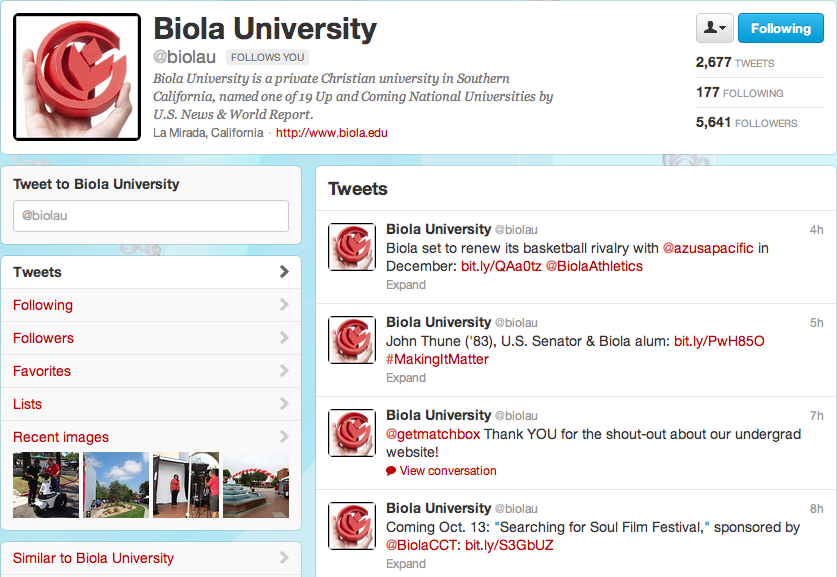
Courtesy | twitter.com/biolau
This year, Biola made the StudentAdvisor Top 100 Social Media Colleges List for the third time, and ranked among prestigious schools such as Harvard University and Stanford University.
“Twitter is on the rise,” said Brett McCracken, social media manager, university writer and managing editor of the Biola Magazine. “We have the most Twitter followers of any Christian college [in the nation].”
However, Biola isn’t just stopping at Twitter. According to the June 2012 Council for Advancement and Support of Education Social Media Survey, investing in social media is one of the most dominant ways a university can succeed.
“Institutional buy-in, in-house expertise and departmental control of social media efforts all contribute to … success [for the college],” according to the survey.
For this reason, the marketing and social media departments at Biola are alive and growing.
Social media platforms distinguish Biola apart from other universities
“Social media is so important because it offers prospective students unfiltered ‘free samples’ of Biola's academic, social and spiritual life,” said Brian Bowman, associate director of Biola’s advertising and marketing research department.
Through Biola’s social media uses, prospective students are given a major taste of what attending the university could be like for them, according to Bowman. They can see what the school has to offer as they interact with Biola’s Facebook page — asking questions and seeking answers.
“We are heavily dependent on social media, and social media promotions, for our successes in enrolling students,” Bowman said.
Through social media such as Twitter and Facebook, Biola has distinguished itself among Christian universities through such examples as Biola’s Klout score.
Klout.com scores how influential a user is through compiling and analyzing all of a user’s social media.
Although everyone’s score fluctuates daily, Biola’s Klout score remains consistently above other Christian universities. As of Sept. 15, Biola had a score of 58, while Azuza Pacific University was at 53.
“We are significantly ahead of our competitors in terms of social media,” McCracken said.
Apart from Biola, the Council for Advancement and Support of Education study showed that 91 percent of all colleges surveyed use Facebook to market their school, yet only 56 percent use Twitter.
However, Twitter has continued to gain momentum in recent years, surpassing Facebook’s growth rate by nearly 19 percent in 2011, according to eMarketer. In 2014, Twitter’s growth rate is expected to quadruple that of Facebook.
Students utilize Twitter as social media continues to revolutionize communication
Although Biola continues to market using Facebook, Twitter has proved to be a major mode of communication for the school. Many incoming students had been following Biola’s Twitter before they even enrolled for school.
“I started following when I was a prospective student,” said Lauren Clark, a freshman business marketing major. “Twitter is useful in promoting Biola because it really demonstrates what they strive for in a Christian university.”
Others find Biola’s Twitter feed to be a place of daily encouragement.
“It was really inspiring to read,” said Alyssa McCoy, a freshman with an undeclared major. “I always like the articles they post — whether it’s a speech or simply a quote.”
On the other hand, sophomore journalism major Grace Freeberg uses Biola’s Twitter as a source of information on events within Biola’s community, as well as to get Biola’s perspective on controversies it’s facing, such as lawsuit issues or other breaking news.
Online, Dean Tsouvalas, editor-in-chief of StudentAdvisor website said “Social media has revolutionized how colleges communicate. These [colleges] are the ones to watch,” of schools who also made the site’s top 100 list.
Even though Biola considers making the list to be an honor, McCracken still thinks there are ways Biola can progress.
“We always want to be improving and making sure we’re on the leading edge of social media,” he said.
With these results, McCracken is confident that Biola’s approach continues to be revolutionary.







